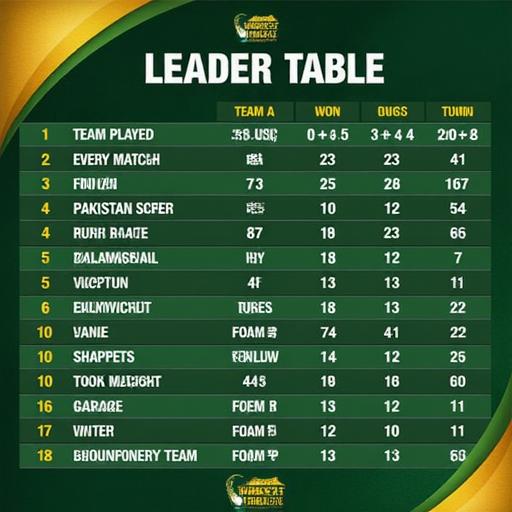Pakistan Cricket Squad for the 1982 Australia Series: A Look Back at a Crucial Era

Pakistan Cricket Squad for the 1982 Australia Series: A Look Back at a Crucial Era
The 1980s were a pivotal decade for Pakistan cricket, a period of both significant challenges and emerging promise. This article will delve into the Pakistan squad that faced the formidable Australian side in 1982, exploring the players, the context of the matches, and the lasting impact that series had on the game’s trajectory.
A Time of Transition: The 1980s Pakistan Cricket Landscape
The 1980s saw Pakistan cricket grappling with internal issues while also contending with powerful international rivals. The cricketing world was changing; the era of the “All-rounder” was slowly evolving into a time of increased specialization, with teams finding success by strategically constructing their squads. The 1982 Australia series, therefore, marked a crucial moment for Pakistan. Did the players rise to the challenge, or did the pressures prove too much? Let’s explore the answers.
The Squad: A Roster of Skill and Potential
The Pakistan cricket team in 1982 was composed of a mixture of seasoned players and emerging talent. We see the names of legendary figures, familiar to fans of the time, interwoven with younger players eager to make their mark on the international stage. This combination of experience and enthusiasm defined the team’s approach to the series. We’ll examine each individual and their contributions to understanding the overall team dynamics and strategies employed in that era.
Key Players: Examining the Heart of the Squad
A notable figure in this squad was Imran Khan. While he’s primarily remembered as a captain and legend, the 1982 tour saw him already starting to etch his name into the history books. His presence influenced the approach to the game, whether in batting, bowling, or fielding. Analyzing his individual performance is critical in understanding the entire team’s approach during this series.
Another crucial figure was Javed Miandad. His presence signified the importance of consistent scoring and strong batting. Miandad often became a cornerstone for Pakistan’s innings. Examining his role and contributions offers insights into the team’s batting strategies. The series also saw promising youngsters who began to develop skills that would serve them well in the years to come. Their presence in the squad demonstrated the team’s commitment to nurturing future stars. Such observations are vital in understanding the long-term impact of this period in Pakistan cricket.
Furthermore, the team included influential bowlers like Wasim Akram, still in early years of his career. The presence of experienced players, combined with the emerging talents, likely contributed to the team’s overall strategy. This meant looking at a balance between experience and youth, between the past and the future.
The Context of the Series: Australia’s Dominance and Pakistan’s Efforts
Australia, during the 1980s, was a force to be reckoned with. Their dominance in world cricket was a significant factor for Pakistan to face. Analyzing the playing conditions, the specific venues where the matches were played, and the crucial moments from each game is critical to understanding the context of the series. The team faced formidable opposition, yet their spirit and determination provided a narrative for the series. We will dive into the challenges and successes faced by Pakistan during the matches in detail. This analysis will showcase the team’s character under pressure.
The Challenges and Triumphs: A Look at the Outcomes
The series inevitably presented numerous challenges for Pakistan. Examining the key statistics like runs scored, wickets taken, and the overall scores in each game will give us a deeper understanding of the intensity and difficulties faced during this period. Understanding the results of these matches gives context to Pakistan’s development as a cricketing nation in that time period. This was a moment in time, when Pakistan tried to rise against a strong opponent, showing their progress and the struggles.
It’s important to remember that these encounters were more than just sporting events; they were a reflection of the time. The series showcased the spirit and determination of Pakistan cricket, while highlighting the strength of the Australian side. The narrative surrounding this rivalry is critical to understanding the cultural and psychological aspects of the game at that moment.
The Lasting Impact: Shaping the Future of Pakistani Cricket
The 1982 series was a stepping stone. Did the outcomes of this series lay the groundwork for the Pakistan cricket team’s future success or struggles? Understanding this context helps explain Pakistan’s progress in international cricket in subsequent years. This period also offers valuable insights into the development of strategies, tactics, and attitudes within the team and, indeed, the wider sport. Evaluating the team’s performance through this lens offers profound understanding into the evolution of the game.
The emergence of young players during this series is critical to analyze in terms of the longer-term effects. Did this series provide a platform for them to develop? Were the coaches effective in guiding and developing future stars during this period? The series highlighted the delicate balance between established players and emerging talent, an aspect still relevant in international sports today. This era gave birth to legends and potential future stars.
Conclusion: Beyond the Scoreboard
The 1982 Pakistan cricket squad’s encounter with Australia wasn’t merely a series of matches; it was a microcosm of the evolution of Pakistan cricket. The squad’s efforts against a dominant opponent, the successes and setbacks, the challenges and triumphs, all contribute to a rich narrative in cricket history. This article aims to explore those elements, not just for the sake of historical record, but to illuminate the broader context of the game’s evolution.
This series offers a fascinating glimpse into the minds and motivations of the players, the strategies implemented by the coaches, and the pressure faced by the entire team. By going beyond the mere numbers, we can truly appreciate the significance of this encounter and its place in the history of Pakistan cricket.